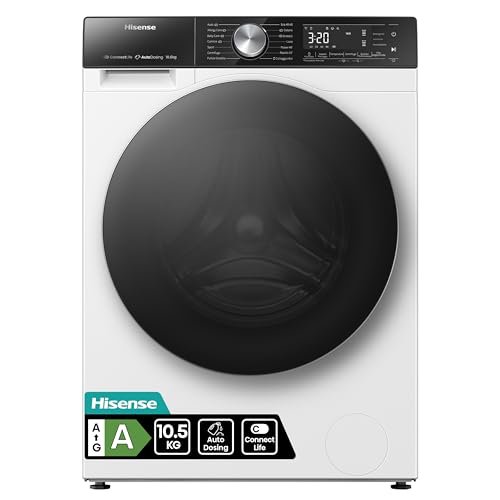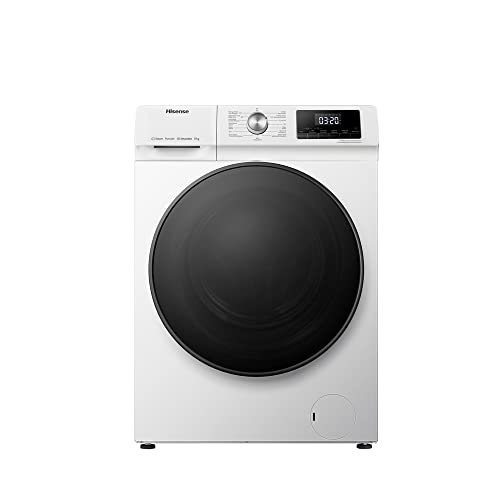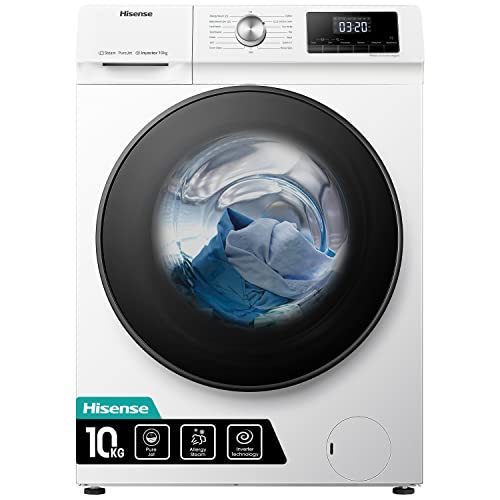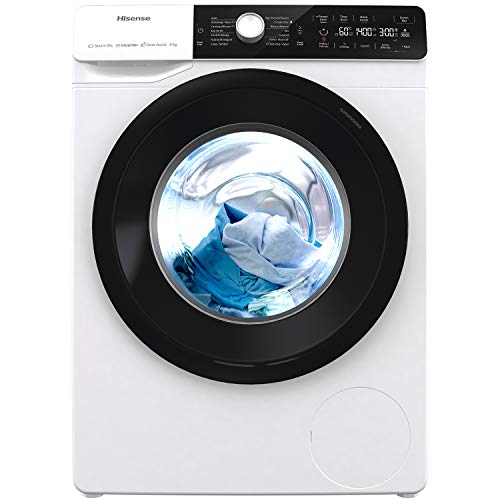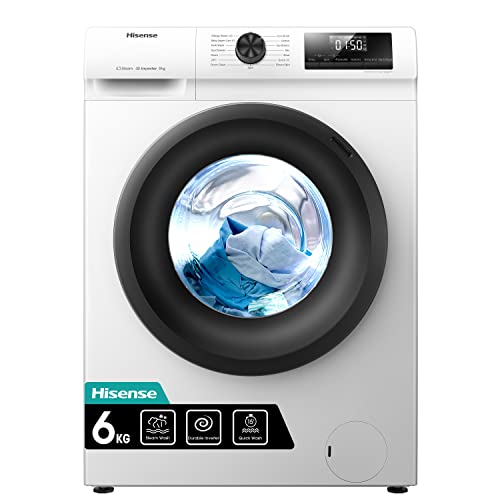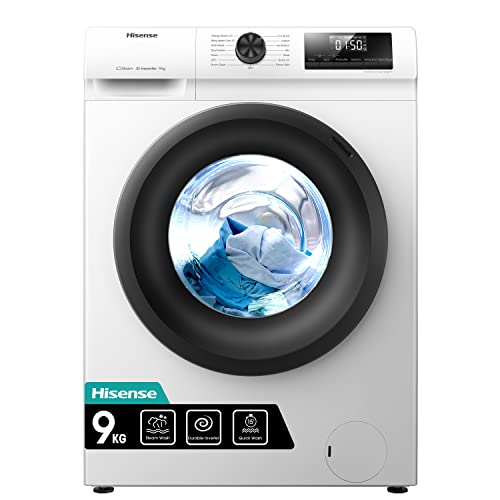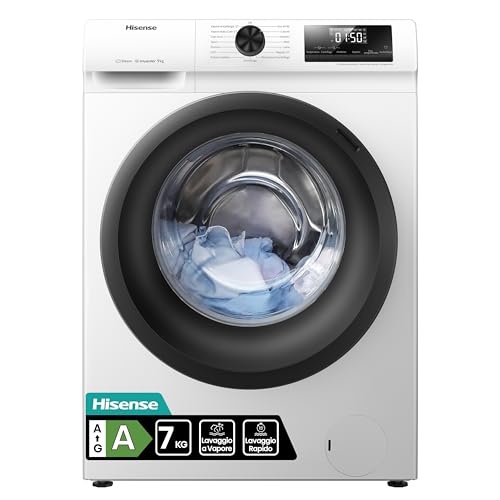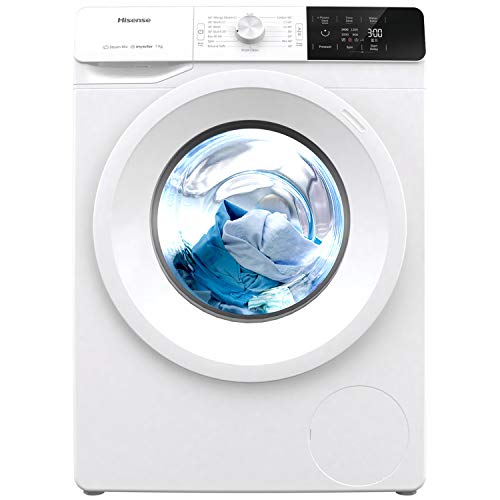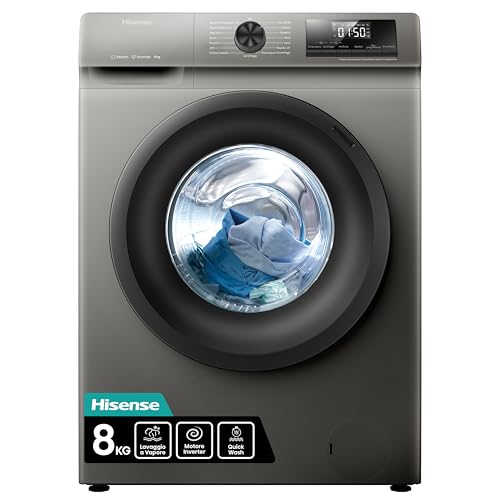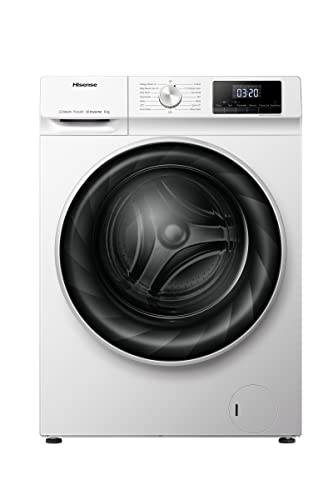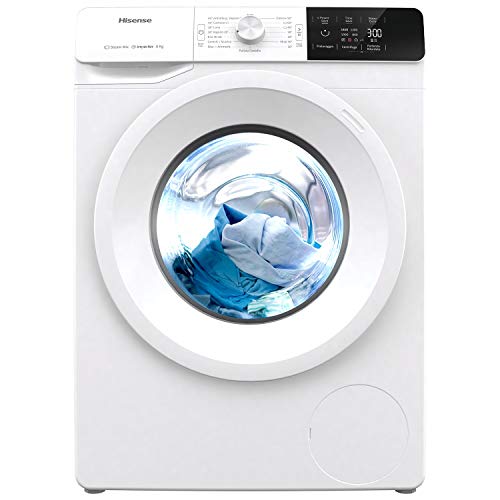Are Hisense washing machines good?
Hisense washing machines rank #12 in the overall brand ranking of washing machines, with an average overall score of 7.1 points.
In user evaluations, Hisense washing machines are ranked #7, with a score of 8.4 points.
Hisense is a solid choice when buying a washing machine and achieves a similar average overall score to AEG, Electrolux, or Beko.
(Note: The ranking includes 22 brands, excluding those with fewer than 6 products in the database.)
The following chart compares the overall scores of the top washing machine brands.
[horizontal-chart-39866564]
The following Hisense washing machines received the highest overall scores.
- Hisense WF5S1045BW 5S Series (Overall score: 7.73 points; Capacity: 10.5 kg)
- Hisense WFQA8014EVJM QA Serie (Overall score: 7.52 points; Capacity: 8 kg)
- Hisense WFQA9014EVJM QA Serie (Overall score: 7.44 points; Capacity: 9 kg)
The Hisense washing machines with the highest user ratings are the following:
- Hisense WFQA8014EVJM QA Serie (Users rating: 8.88 points; Capacity: 8 kg)
- Hisense WFQA9014EVJM QA Serie (Users rating: 8.88 points; Capacity: 9 kg)
- Hisense WFQP9014EVM QPSerie (Users rating: 8.88 points; Capacity: 9 kg)
What are the main advantages of Hisense washing machines?
Hisense washing machines offer the following advantages compared to other brands.
- Higher popularity and ratings: Hisense washing machines achieve an average popularity score of 9.9 points, above the market average of 6 points.
- Lower price: Hisense washing machines are on average £50 cheaper (£330 vs £380 market average) with a better ratio quality-price (7.3 points vs 7.1).
- Lower water consumption: Hisense washing machines consume an average of 42 litres per cycle, compared to 46 litres market average.
- Quieter operation: Hisense washing machines have a spin noise level of 74 dB, slightly quieter than the market average of 75 dB.
- Many washing programs: Hisense washing machines offer 15 washing programs, on par with most other brands.
- Specialised wash cycles: Many Hisense models include cycles like Allergy Steam, Sports, Shirts, Duvets, Baby Care, and Dark Wash.
- Customisable washing functions: Features include fast function (Time Save or Quicker), anti-stain function, anti-crease function, rinse hold, Eco Care, Water+/Water Extra, prewash, and silent mode (Sounds Off).
- Essential features: All Hisense washing machines include Drum Clean, unbalanced load detection, foam control system, and delay start option. Most models also have an inverter motor, laundry detection system, steam technology, smart diagnosis, and a favourites function.
- Advanced features: Select Hisense models offer Wi-Fi connectivity (via the ConnectLife app), AquaStop system, PureJet system, AI technology, and drum light.
- Unique drum design: Hisense washing machines feature specially designed drums to gently handle fabrics while effectively removing stains (Snowflake, Wave Plus, or Raindrop drums).
- Enhanced stability and hygiene: Some models include Stable Tech side panels to reduce vibration and an antibacterial rubber seal Hygiene Guard.
What are the main disadvantages of Hisense washing machines?
Hisense washing machines have the following disadvantages compared to other brands.
- Smaller drum volume: Hisense washing machines have an average drum volume of 54 litres, below the market average of 58 litres.
- Higher energy consumption: Hisense washing machines consume an average of 56 kWh per 100 cycles, slightly above the market average of 55 kWh.
- Not ideal for very delicate fabrics: The minimum spin speed of Hisense washing machines is 800 rpm, compared to 400 rpm offered by most washing machines on the market.
- Limited washing cycles: Hisense washing machines do not offer a Jeans cycle or Hygiene cycle.
- Lack of advanced features: Hisense washing machines do not include pre-mix technology, automatic drawer cleaning, or automatic dosing systems.
Who manufactures Hisense washing machines?
Hisense washing machines are manufactured by the multinational Chinese group Hisense Group, founded in 1969 in Qingdao, Shandong province, China. Originally a small radio factory, Hisense has progressively expanded its production to include a wide range of products such as televisions, air conditioners, refrigerators, and washing machines.
In the late 2000s, Hisense entered the washing machine market through a strategic joint venture with Whirlpool, quickly establishing itself in the global appliance sector. Hisense washing machines are designed and produced in multiple global locations, with major facilities in China, South Africa, and Hungary. These plants enable Hisense to efficiently meet the needs of different markets while maintaining high-quality standards.
Hisense’s expansion included the acquisition of well-known brands such as Sharp and Toshiba, further enhancing its production capabilities and brand recognition. In 2018, Hisense became the majority shareholder of the Slovenian manufacturer Gorenje, solidifying its position in the European market.
What are the different series of Hisense washing machines?
The different series of Hisense washing machines are as follows.
- VC Series: Includes laundry detection, foam control system, unbalanced load detection, drum clean, and smart diagnosis. Missing AquaStop, steam technology, quick function, rinse hold, anti-crease, and anti-stain functions. Energy class E, 6-7 kg capacity, usually 15 wash programs.
- VB/HV/PV Series: Adds steam technology, allergy steam, and extra rinse to VC features but lacks AquaStop, quick function, rinse hold, anti-crease, and anti-stain functions. Energy efficiency varies from D to E, with a capacity of 7-9 kg and 15 wash programs.
- GE/GC Series: Features an inverter motor, steam technology (Allergy Steam), auto wash, foam control, load balancing (UKS Stability Control System), anti-crease function (Steam Mix), quick function (Time Save), Aqua+ function, drum clean, and energy-saving mode. Design features include Wave Plus drum, easy-load door, and Stable Tech side walls. No Wi-Fi connectivity or automatic dosing system. Energy classes A to B, 7-9 kg capacity, 11-14 wash programs.
- GA Series: Extends GE/GC with Power Wash 59' (reduces wash time by 50% and energy/water use by 45%), Dose Assist (recommends optimal detergent quantity), and Green Bar display (shows setting efficiency). Energy class ranges A to B, 8-9 kg capacity, generally 14 wash programs.
- GS Series: Based on GA, replaces Power Wash 59' with IonWash 59' (uses ionised air for eco-friendly washing), replaces Power Save with Eco Care, and Green Bar display with Eco Eye. Energy class A, 10 kg capacity, 14 wash programs.
- QP/QA/QE/QY Series: Includes Durable Inverter motor, Pure Steam technology, allergy and baby steam care, laundry detection, foam control, unbalanced load detection, extra rinse, anti-stain function (Intensive), drum clean, Pure Jet system (except QP), favourites function, and smart diagnosis. Missing Wi-Fi, automatic dosing, AquaStop, quick function, rinse hold, and anti-crease. Energy classes A to C, 6-10 kg capacity, 14 wash programs.
- QR Series: Adds automatic dosing (detergent/softener lasts 14 uses), a 15° tilted control panel (for easier use), and a large LED touchscreen to QP/QA/QE/QY features. Energy class A, 10 kg capacity, 14 wash programs.
- 3S Series: Includes Wi-Fi connectivity (via ConnectLife app with Energy Monitoring, Smart Assist, Smart Link, and Smart Wizard), Durable Inverter motor, steam technology, laundry detection, foam control, unbalanced load detection, quick function (Quicker), fast washes (15/30/49 min), extra rinse, anti-crease (Steam Wash), drum clean, Pure Jet system, and smart diagnosis. Design elements include a large LED control display and Hygiene Guard antibacterial rubber seal. Some models may feature automatic dosing. Energy classes A to A-30%, 8-12 kg capacity, 19 wash programs.
- 5S Series: Includes all 3S features and adds automatic dosing (stores detergent/softener for 24 loads) and RainDrop drum. Energy class A, 10.5-12 kg capacity, 19 wash programs.
- 7S Series: Extends 5S with AI Super Wash (automatically selects the perfect wash cycle), intelligent dosing (AI sensors calculate precise detergent/softener dosing), and a customisable program menu (to define wash program order). Includes smart display (6.86-inch colour touchscreen) and drum light. Energy class A-20%, 12 kg capacity, 20 wash programs.
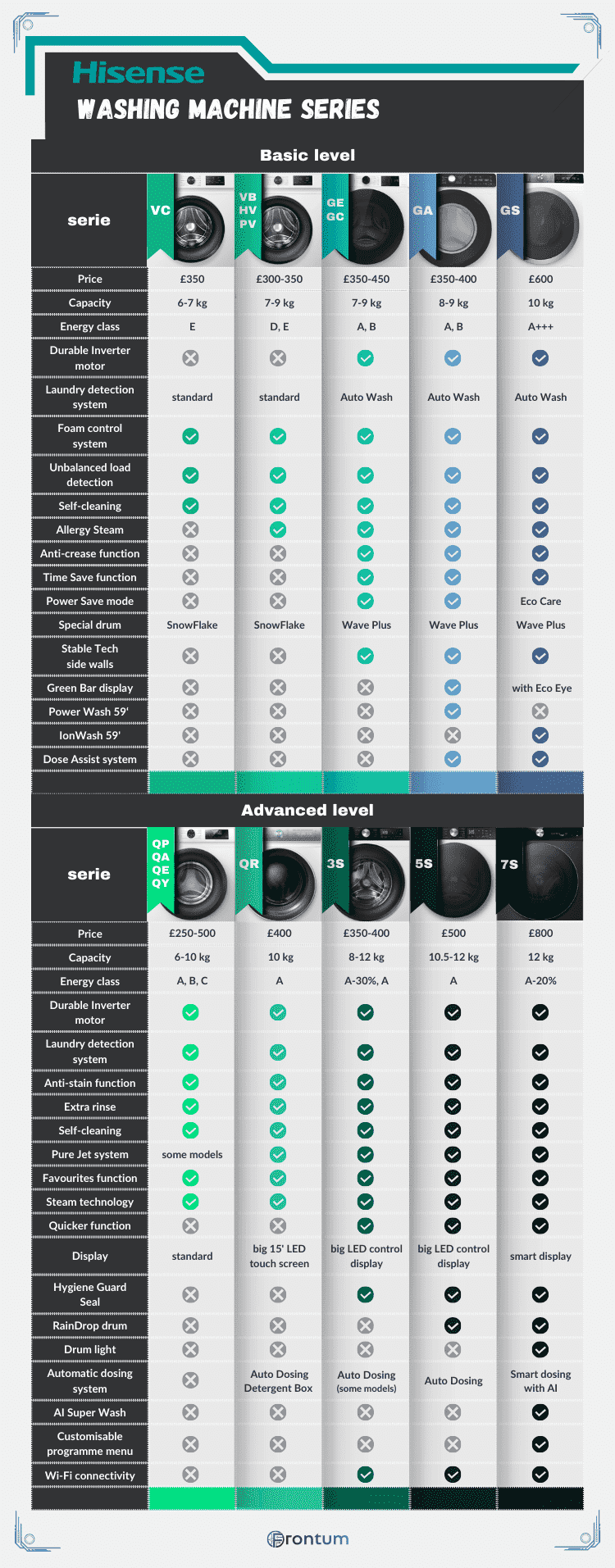
What is the warranty period for Hisense washing machines?
Hisense washing machines include a 2-year service warranty. Additionally, by registering the product, you receive a 10-year warranty for the Durable Inverter motor.
How much do Hisense washing machines cost?
Hisense washing machines are priced between £250 and £850, with an average cost of around £330. This places them at #6 in the price ranking among 22 brands, while the market average price for washing machines is £380.
The most affordable Hisense models belong to the VC, VB, HV, PV, GE, GC, and GA series, priced between £300 and £450. The GS, QR, 3S, and 5S series reach prices of up to £600, while the 7S series can cost up to £800.
In terms of value for money, Hisense ranks #6 with an average score of 7.3 for ratio quality-price.
Note: Brands with fewer than 6 products in the database were not included in the ranking.
The following chart illustrates the price distribution of Hisense washing machines.
[vertical-chart-24429508]
The most affordable Hisense washing machines are as follows.
- Hisense WFQP6012EVM QP Serie (~£250, 6 kg)
- Hisense WFQA1014EVJM QA Serie (~£320, 10 kg)
- Hisense WFQP9014EVM QPSerie (~£340, 9 kg)
The most expensive Hisense washing machines are as follows.
- Hisense WF5S1045BW 5S Series (~£520, 10.5 kg)
- Hisense WFQA8014EVJM QA Serie (~£380, 8 kg)
- Hisense WFGA80141VM GA Serie (~£350, 8 kg)
The following Hisense washing machines offer the best value for money.
- Hisense WFQP6012EVM QP Serie (Ratio quality-price: 7.89 points; Capacity: 6 kg)
- Hisense WFQA1014EVJM QA Serie (Ratio quality-price: 7.69 points; Capacity: 10 kg)
- Hisense WFQA9014EVJM QA Serie (Ratio quality-price: 7.61 points; Capacity: 9 kg)
What should you consider when choosing the best Hisense washing machine?
To choose the best Hisense washing machine, consider factors such as drum capacity and volume, dimensions, energy consumption, water usage per cycle, spin efficiency, noise level during washing, motor type, and available washing programs and features.
What capacities are available for Hisense washing machines?
Hisense washing machines have capacities ranging from 6 to 10 kg. The most common capacities are 8 kg (32% of models) and 9 kg (23% of models). Washing machines with 6 or 7 kg capacity are ideal for individuals or couples, while 8 or 9 kg machines suit families. Drum volume ranges between 43 and 68 litres, with an average of 54 litres, below the market average of 58 litres.
The following chart shows the distribution of capacities among Hisense washing machines.
[pie-chart-80804434]
Hisense washing machines range in depth from 45 to 66 cm, so slim models are available if space is limited. Standard width for Hisense models is 60 cm, matching the market average.
The best Hisense washing machines with a 7 kg capacity are as follows.
- Hisense WFQE7012EVM QE Serie (Overall score: 7.43 points)
- Hisense WFGE70141VM GE Serie (Overall score: 7.41 points)
- Hisense WFQP7012EVM QP Serie (Overall score: 6.57 points)
The following are the best Hisense 8 kg washing machines available.
- Hisense WFQA8014EVJM QA Serie (Overall score: 7.52 points)
- Hisense WFGA80141VM GA Serie (Overall score: 7.34 points)
- Hisense WFQP8014EVMT QP Serie (Overall score: 7.27 points)
What is the energy efficiency of Hisense washing machines?
Hisense washing machines are generally energy efficient, with classes ranging from A to E. Approximately 41% of models fall under class A, 18% under class B, another 14% under class C, 9% under class D, and 14% under class E. There are no Hisense models in classes F or G. Compared to the market average, where around 39% of washing machines are in class A, Hisense lags slightly behind.
The most efficient Hisense models belong to the 3S, 5S, and 7S series, with classifications including A-30%, A-20%, or A.
The following chart shows the distribution of energy classes among Hisense washing machines.
[pie-chart-75549938]
Energy consumption for Hisense washing machines ranges from 45 to 76 kWh per 100 cycles, averaging 56 kWh, placing them 12th out of 22 brands for energy consumption. The market average is around 55 kWh per 100 cycles.
Water consumption for Hisense washing machines ranges from 36 to 49 litres per cycle, averaging 42 litres. This positions Hisense 2nd out of 22 brands for the lowest water consumption.
The following Hisense washing machines have the lowest energy consumption.
- Hisense WFQA8014EVJM QA Serie (Energy consumption: 47 kWh/100 cycles per 100 cycles; Capacity: 8 kg)
- Hisense WFQA9014EVJM QA Serie (Energy consumption: 49 kWh/100 cycles per 100 cycles; Capacity: 9 kg)
- Hisense WFQA1014EVJM QA Serie (Energy consumption: 52 kWh/100 cycles per 100 cycles; Capacity: 10 kg)
What is the spin efficiency of Hisense washing machines?
The spin efficiency of Hisense washing machines varies between classes A and C, with class B being the most common, representing 91% of models. This trend is similar to the general market, where class B makes up 85%. Spin efficiency class is a crucial performance indicator as it measures the amount of moisture removed during the spin cycle, directly dependent on the maximum spin speed.
The following chart shows the distribution of spin efficiency classes among Hisense washing machines.
[pie-chart-17282683]
Hisense washing machines have a maximum spin speed ranging from 1200 to 1400 rpm. Most models (64%) reach 1400 rpm, while 31.6% cap at 1200 rpm. This distribution aligns well with the market, where 60% of models reach 1400 rpm, and 22% max out at 1200 rpm.
If you often wash delicate garments, it’s worth considering the minimum spin speed as well. Lower speeds help preserve delicate fabrics.
In Hisense washing machines, the minimum spin speed typically ranges from 600 to 800 rpm, and less than 10% of models can spin at 400 rpm. This percentage is significantly lower than the market average, where 67% of washing machines can spin at 400 rpm.
How noisy are Hisense washing machines?
Hisense washing machines have a spin noise level ranging from 72 dB to 77 dB, averaging 74 dB. This places Hisense 8th out of 22 brands in terms of quietness, being quieter than most other brands, which average 75 dB. Spin noise is the main indicator of overall noise levels, as it is the loudest phase of the washing cycle.
The following chart shows the distribution of spin noise levels among Hisense washing machines.
[vertical-chart-73110311]
Hisense washing machines fall under noise emission classes A (below 73 dB) to B (between 73 and 76 dB), with class B characterising 63% of Hisense washing machines. By comparison, in the general market, 37% of washing machines fall under class A, 35% under class B, 26% under class C, and only 3% under class D.
Noise levels during washing are also relevant. Hisense washing machines produce noise levels between 52 dB and 58 dB, with 58 dB being the most common value (above the market average of 53 dB).
The quietest Hisense washing machines are as follows.
- Hisense WFQA8014EVJM QA Serie (Spin noise level: 72 dB; Capacity: 8 kg)
- Hisense WFQA9014EVJM QA Serie (Spin noise level: 72 dB; Capacity: 9 kg)
- Hisense WFQA1014EVJM QA Serie (Spin noise level: 72 dB; Capacity: 10 kg)
How many wash programs do Hisense washing machines offer?
Hisense washing machines have 14-15 wash programs, similar to most other brands. Common programs include Cotton, Eco 40-60, Synthetics, Quick 15', Mixed, Wool, Coloured Cotton, Duvet, Allergy Steam, Baby Care/Baby Steam Care, Sports/Sportswear, Shirts, and Dark Wash. Some include an Auto Wash program that automatically adjusts the cycle, wash duration, and rinses based on the laundry amount.
The following chart highlights the distribution of available wash programs in Hisense washing machines.
[vertical-chart-81216966]
Advanced models, such as those in the GA Series, also include the Power Wash 59' cycle, which reduces wash times by 50% and uses 45% less energy and water. Models in the GS Series feature the IonWash 59' cycle, which uses ionised air for eco-friendly stain removal.
Some cycles are more common in Hisense washing machines compared to other brands, such as the Duvet cycle (present in 68% of models vs 46% in other brands), Baby-Care cycle (74% vs 39%), Allergen/Allergy Steam cycle (89% vs 68%), and Sports cycle (89% vs 67%). However, Hisense does not include the Jeans cycle (present in 45% of other brands) or the Hygiene cycle (compared to 59% in other brands).
The ECO cycle of Hisense washing machines lasts between 196 and 238 minutes, with an average of 208 minutes, slightly shorter than the market average of 218 minutes. Additionally, Hisense washing machines feature 1-3 quick cycles under an hour (Quick 15', Quick 20', Power Wash 59'/IonWash 59'), with the fastest being 15 minutes.
Hisense washing machines include the following options to customise wash cycles.
- Quick function: Time Save function (only in G Series) or Quicker function (only in 3S, 5S, and 7S Series).
- Anti-stain function: Intensive function that extends washing time, increases washing efficiency, and improves stain removal (only in Q Series) or anti-stain function with IonGen technology (only in GS Series) that removes various types of stains using ionised air washing to enhance washing power and dissolve more stains.
- Anti-crease function (only in 3S, 5S, and 7S Series): Keeps laundry soft and less creased even after the cycle ends, thanks to automatic drum rotation.
- Rinse hold function (only in G Series): A variant of the anti-crease function, keeps laundry in water until the final spin starts, helping to reduce creases in fabrics.
- Eco Care (only in G Series): Extends washing time to save energy and reduce water consumption.
- Extra rinse function: Adds an extra rinse to the wash cycle.
- Water+ function (only in G Series): Increases water level for the load.
- Prewash function: Includes an additional wash before the main cycle.
No Hisense washing machine has a soak function.
What are the common features of Hisense washing machines?
Hisense washing machines offer between 5 and 15 features, with an average of 7 per model (below the market average of 10).
The following chart shows the distribution of features in Hisense washing machines.
[vertical-chart-94397998]
All or nearly all Hisense washing machines include the following features.
- Self-cleaning: The Drum Clean function ensures a deep clean at 95℃.
- Unbalanced load detection: Detects drum imbalances during washing and alerts the user.
- Foam control system: Detects excess foam during washing and activates extra rinses for optimal results.
- Delay start option: Maximum delay is 24 hours in most Series and 12 hours in the VC Series.
- Pause and add: Allows forgotten items to be added within the first 10 minutes of the cycle.
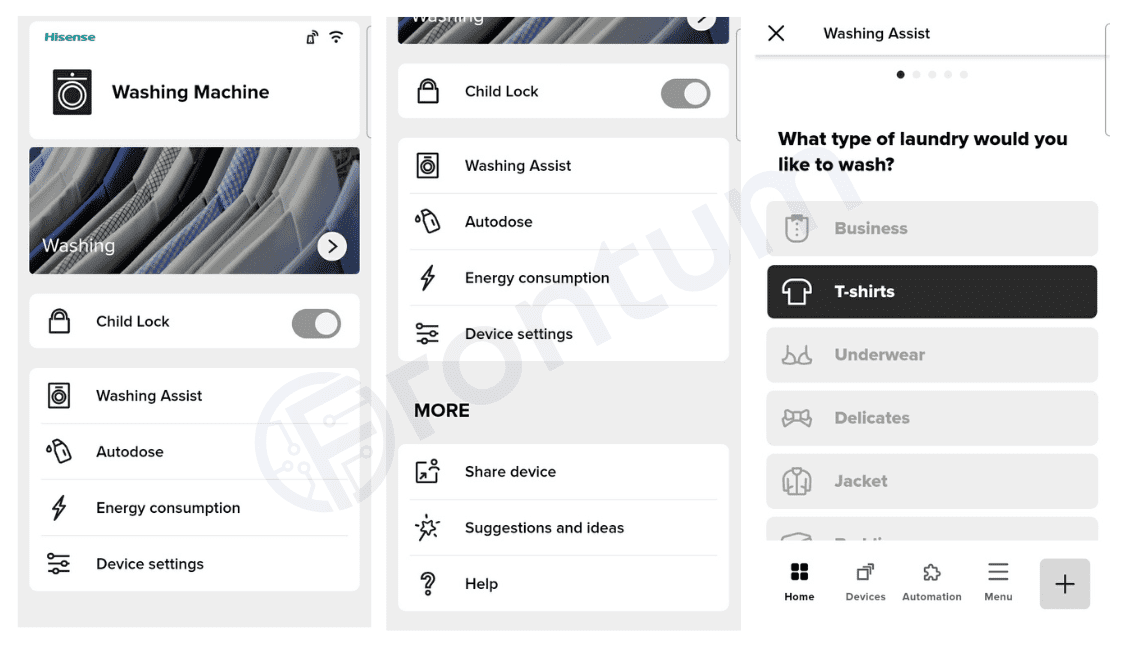
Other common features of Hisense washing machines include are as follows.
- Durable Inverter motor (74% of Hisense models; present in all series except VC, VB, HV, and PV)
- Laundry detection system: Adjusts cycle duration based on laundry weight. The G Series instead features an automatic wash program.
- Steam technology (89% of Hisense models): Available in various forms, such as Pure Steam/Steam Wash (Q Series), Steam Expert (GS Series), and Allergy Steam (GE, GC, GA, 3S, 5S, and 7S Series).
- Smart diagnosis (74% of Hisense models): Displays error codes on the screen for easy troubleshooting.
- Favourites function (47% of Hisense models; only in Q Series): Saves preferred washing settings.
- Aqua Stop (32% of Hisense models; available only in G, 3S, 5S, and 7S Series.): Safety device that automatically shuts off water flow in case of leaks.
- Sound off function: Mutes alerts and audio notifications. Available in the 3S, 5S, and 7S Series.
Hisense washing machines feature a special drum design intended to handle fabrics gently while effectively removing stains. The VC, VB, HV, and PV Series use the Snowflake drum, the G and 3S Series use the Wave Plus drum, while the 5S and 7S Series use the RainDrop drum.
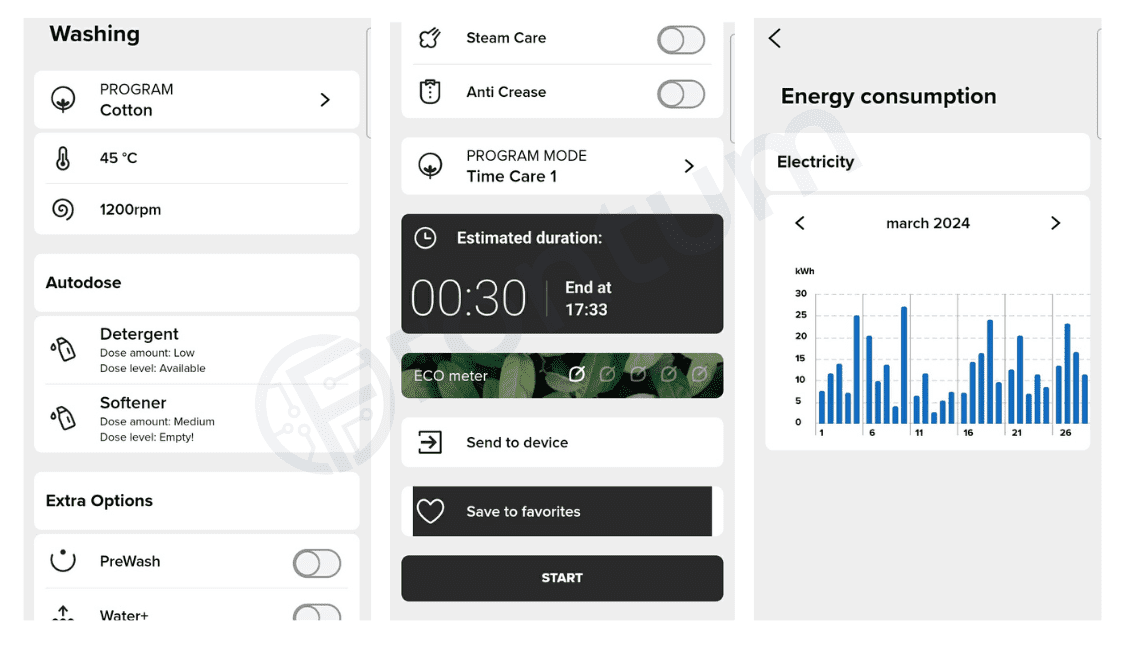
Advanced Hisense models also include the additional features listed bellow.
- UKS load balancing system (31% of Hisense models): Evenly distributes laundry in the drum to prevent imbalances during spinning, reducing vibrations and noise.
- Wi-Fi connectivity (3S, 5S, and 7S Series): Allows remote control via the ConnectLife app.
- PureJet system (only in QA, QY, QR, 3S, 5S, and 7S Series): Produces powerful water jets for more effective cleaning.
- AI technology: Includes AI Super Wash, which uses sensors to adapt the wash cycle based on the garments.
- Customised program menu (only in 7S Series): Lets you design and organise wash programs.
However, Hisense washing machines lack pre-mix technology (found in 24% of all washing machines) and automatic drawer cleaning (found in 12% of washing machines). Additionally, no Hisense washing machine has an automatic dosing system, but they offer Dose Assist, which recommends the optimal amount of powder or liquid detergent based on the selected settings.
The Hisense washing machines with the highest number of features are as follows.
- Hisense WF5S1045BW 5S Series (19 features, 10.5 kg)
- Hisense WFGA80141VM GA Serie (15 features, 8 kg)
- Hisense WFQA8014EVJM QA Serie (11 features, 8 kg)
Front-load or top-load: which type of Hisense washing machine is better?
Most Hisense washing machines are front-loading models. There are very few top-loading models. If you prefer a top-loading washing machine, consider other brands.

